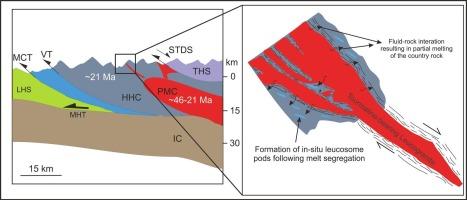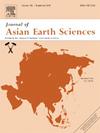Origin of leucosomes in a Kyanite-Zone migmatite of the Higher Himalayan Crystallines, Bhagirathi Valley (NW Himalaya)
IF 2.4
3区 地球科学
Q2 GEOSCIENCES, MULTIDISCIPLINARY
引用次数: 0
Abstract
This study encompasses field observations, petrography, whole-rock geochemistry, zircon and monazite geochronology, and oxygen isotope analysis to delineate the conditions and timing of partial melting in the Higher Himalaya Crystallines (HHC) along Bhagirathi Valley. Two distinct leucocratic layers (L-1 and L-2) were identified and studied to elucidate their formation mechanisms. Field evidence and petrographic studies indicate that the L-1 layer represents Tourmaline-bearing leucogranite (TBL) veins that infiltrated along extensional shear bands, while L-2 represents in-situ leucosomes generated during the partial melting of metasedimentary rocks. The peak metamorphic conditions were estimated at ∼ 720–740 °C and 1.0 GPa, which suggests that L-2 melts originated by fluid-assisted melting, rather than by closed system dehydration melting. Phase equilibria modelling suggests that protolith bulk composition, particularly the Na/K and Al/Si ratios, plays a critical role in melt chemistry, with elevated Na/K ratios in the host-rock promoting trondhjemite melts while lower Na/K ratios produce granitic melts. Zircon and monazite geochronology document two metamorphic episodes: an event at ∼ 35 Ma, which possibly represents melt generation at greater depth, and a subsequent episode at ∼ 21 Ma representing emplacement due to extensional tectonics. In-situ oxygen isotope analysis of zircon overgrowth suggests that intrusion of L-1 was accompanied by assimilation of surrounding metapsammite, recorded by a progressive increase in δ1⁸O values from 7.5 ‰ at ∼ 25 Ma to 8.7 ‰ at |∼ 23 Ma. The high δ1⁸O value (8.7 ‰) recorded by L-2 bearing migmatite is consistent with an origin by partial melting of a metapsammite protolith.

喜马拉雅西北部Bhagirathi山谷高喜马拉雅晶石蓝晶石带杂岩中白色小体的成因
本研究包括野外观测、岩石学、全岩地球化学、锆石和独居石年代学以及氧同位素分析,以描绘沿Bhagirathi山谷的高喜马拉雅结晶(HHC)部分熔融的条件和时间。鉴定并研究了两个不同的白蛋白层(L-1和L-2),以阐明其形成机制。现场证据和岩石学研究表明,L-1层为沿张性剪切带渗透的含电气石白花岗岩脉,L-2层为变质沉积岩部分熔融形成的原位白花岗岩脉。在~ 720 ~ 740°C和1.0 GPa的条件下估计了峰值变质条件,这表明L-2熔体起源于流体辅助熔融,而不是封闭系统脱水熔融。相平衡模型表明,原岩体积组成,特别是Na/K和Al/Si比值,在熔体化学中起着关键作用,主岩中Na/K比值的升高促进了长闪长岩熔体的熔化,而Na/K比值的降低则产生了花岗岩熔体。锆石和独居石年代学记录了两个变质期:一个发生在~ 35 Ma的变质期,可能代表更深深度的熔体生成,另一个发生在~ 21 Ma的变质期代表伸展构造引起的侵位。锆石过度生长的原位氧同位素分析表明,L-1的侵入伴随着周围偏砾石的同化作用,δ1⁸O值从7.5‰(~ 25 Ma)逐渐增加到8.7‰(| ~ 23 Ma)。含L-2混辉岩记录的高δ1⁸O值(8.7‰)与偏细粒原岩部分熔融形成的成因一致。
本文章由计算机程序翻译,如有差异,请以英文原文为准。
求助全文
约1分钟内获得全文
求助全文
来源期刊

Journal of Asian Earth Sciences
地学-地球科学综合
CiteScore
5.90
自引率
10.00%
发文量
324
审稿时长
71 days
期刊介绍:
Journal of Asian Earth Sciences has an open access mirror journal Journal of Asian Earth Sciences: X, sharing the same aims and scope, editorial team, submission system and rigorous peer review.
The Journal of Asian Earth Sciences is an international interdisciplinary journal devoted to all aspects of research related to the solid Earth Sciences of Asia. The Journal publishes high quality, peer-reviewed scientific papers on the regional geology, tectonics, geochemistry and geophysics of Asia. It will be devoted primarily to research papers but short communications relating to new developments of broad interest, reviews and book reviews will also be included. Papers must have international appeal and should present work of more than local significance.
The scope includes deep processes of the Asian continent and its adjacent oceans; seismology and earthquakes; orogeny, magmatism, metamorphism and volcanism; growth, deformation and destruction of the Asian crust; crust-mantle interaction; evolution of life (early life, biostratigraphy, biogeography and mass-extinction); fluids, fluxes and reservoirs of mineral and energy resources; surface processes (weathering, erosion, transport and deposition of sediments) and resulting geomorphology; and the response of the Earth to global climate change as viewed within the Asian continent and surrounding oceans.
 求助内容:
求助内容: 应助结果提醒方式:
应助结果提醒方式:


